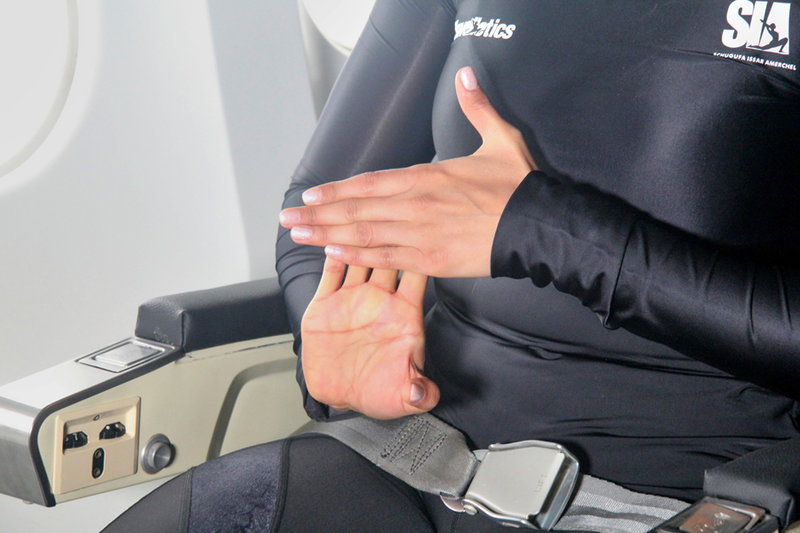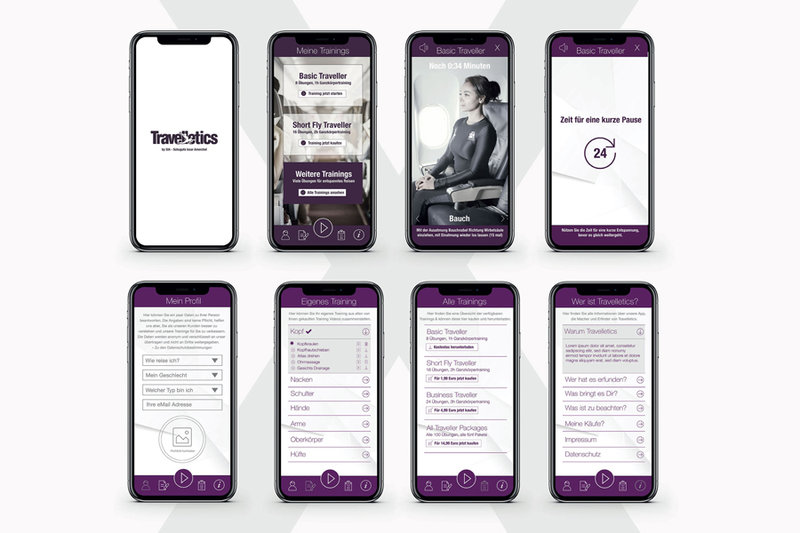Technology
Keeping fit while flying:
a look inside the Travelletics app
Flying is often a stressful and painful experience, requiring passengers to remain seated for hours. For this reason, a fitness trainer has launched the world’s first sports app to feature exercises specifically designed for working out on a plane. Frances Marcellin takes a closer look
Flying is often a stressful and painful experience, requiring passengers to remain seated for hours. For this reason, a fitness trainer has launched the world’s first sports app to feature exercises specifically designed for working out on a plane. Frances Marcellin takes a closer look
Airlines carry over four billion passengers each year – accounting for around 280 million trips by air – and the International Air Transport Association (IATA) estimates that this number will double by 2037.
“In 2000, the average citizen flew just once every 43 months – in 2017 the figure was once every 22 months,” says Alexandre de Juniac, IATA’s Director General and CEO. “Flying has never been more accessible, and this is liberating people to explore more of our planet for work, leisure and education. Aviation is the business of freedom.”
Yet with this freedom, particularly the long-haul kind, comes with associated risks to health and wellbeing. Most air passengers can tolerate the reduced cabin pressure, and the gas expansion and rebalancing (where they may need to ‘pop’ their ears) on take-off and landing. Skin dryness, due to low humidity, can usually be solved with moisturising lotion.
However, the biggest challenge is the lack of space on long-haul flights with immobility leading to increased levels of stress, back pain and discomfort. A new app called Travelletics, designed by Munich-based fitness trainer Schugufa Issar Amerchel (also known as Sia), might just provide the answer.
On this busy Airbus A330 in flight from Dusseldorf to Miami with Air Berlin passengers would be able to work out in their seats using the Travelletics app. Image courtesy of Bigstock.com/ Zaschnaus
Long-haul health problems
The World Health Organisation (WHO) estimates that around one air passenger in every 4,500 will suffer from venous thromboembolism (VTE), a blood clot in the vein that can develop into deep vein thrombosis (DVT) when it affects a deep vein, usually in the leg.
General advice from WHO relays that passengers should move around during the flight - often difficult in reality, especially during night flights - and exercise. Exercising the calf muscles can stimulate circulation; alleviate discomfort, fatigue and stiffness; and reduce the risk of DVT.

Image courtesy of
While in-flight entertainment (IFE) is the most popular way of keeping passengers busy on a long flight, it doesn’t alleviate sedentary time spent in the air.
The new Travelletics app comes equipped with a collection of stretching exercises that can be performed straight from the passenger seat. It is also possible to use the IFE system and do exercises at the same time.
“The idea for Travelletics came up while I was on a long-distance flight of over twelve hours,” says Amerchel. “Whilst sitting, I started with my whole-body workout, then my neighbours looked at me and also joined in.”
Eero Knuutila is Head of Service Development at Helsinki Airport.
Image courtesy: Helsinki Airport
Around one air passenger in every 4,500 will suffer from venous thromboembolism (VTE)
Travelletics: exercises for confined spaces
Previously, Amerchel had told some clients at her fitness classes how to exercise in the air to prevent heavy legs and tension during the flight. “The positive feedback encouraged me to keep thinking about the topic and to develop the sports app idea for the aeroplane,” she says. “Travelletics is the only international sports app offered for the plane.”
Building on this Amerchel spent six months developing the app, which was supported by Isoblitz, one of her customers, and while she carried out the planning, development, content and video footage, the coding of the app was taken over by programmer Stefan Felder.
"The Travelletics exercises are designed to easily work in confined spaces with limited legroom,” says Amerchel. “From the neck and the shoulders up to the legs, the entire body is trained and gently relaxed. That's how the blood circulation gets going on the airplane."

The programme starts with neck and shoulder exercises, which include straightforward stretching movements such as neck circling and shoulder raising and dropping.
After downloading the app and creating a personal profile, users can try out the exercises straight away for free using the Basic Traveller package. This gives access to eight exercises, roughly a 30-minute workout. “All the exercises in the app have been designed especially by me,” says Amerchel.
There are five more packages to choose from, including Short Fly Traveller (14 exercises for €2.99); Long-Distance Traveller (31 exercises for €8.99); Business Traveller (23 exercises for €4.99); Stretching (14 exercises for €2.49); and an All Premium option which provides all the exercises for a one-off price of €14.99.
Overall, the app contains 90 individual full-body training exercises, all of which can be performed while sitting.
“They are very important for people who travel frequently to help prevent thrombosis and circulatory disorders,” says Amerchel.
The Travelletics exercises are designed to easily work in confined spaces with limited legroom
The sky’s the limit
According to Amerchel, the app was medically tested during which ultrasound images were taken of the venous circulation of the body, which is designed to circulate blood. For that reason she says it is recommended by vascular surgery specialist Dr Reza Ghotbi of the Vascular Surgery Clinic in Munich.
The programme starts with neck and shoulder exercises, which include straightforward stretching movements such as neck circling and shoulder raising and dropping. These are also beneficial for relaxation.
There are specific exercises for different parts of the body. “Back pain can be solved by exercises especially for the back,” she says, adding that back exercises are crucial for those sitting for long hours on an aeroplane.
Stretching of hands and fingers is also included, as are exercises that work the abdominal muscles.

The Travelletics app contains 90 individual full-body training exercises, all of which can be performed while sitting.
Amerchel says that the most important exercises come at the end: leg exercises. Calf muscles make up the biggest focus to help prevent water retention, heavy legs and DVT.
In terms of stress, Amerchel explains that stress hormones cannot be broken down while passengers are on long-haul flights due to their lack of movement. “Through these sporty movements while sitting, the stress can now be reduced,” she says.
The exercises are beneficial beyond the skies as well and are just as effective for those travelling by road, sea or air in other vehicles and vessels.
For the moment, Travelletics is available in both English and German, but in the future, Amerchel intends to develop the app further into many other languages so it can be used by passengers all over the world.
“I am particularly proud to be the first person to recognise this lack of exercise and try to remedy this with this app,” says Amerchel.
Eero Knuutila is Head of Service Development at Helsinki Airport.
Image courtesy: Helsinki Airport
Back exercises are crucial for those sitting for long hours on an aeroplane